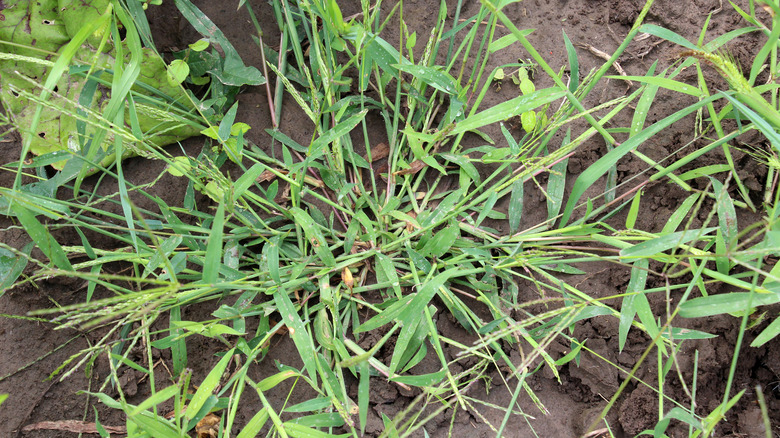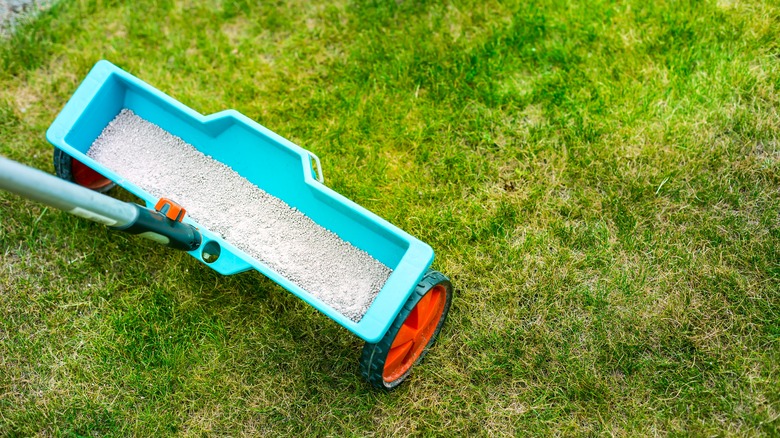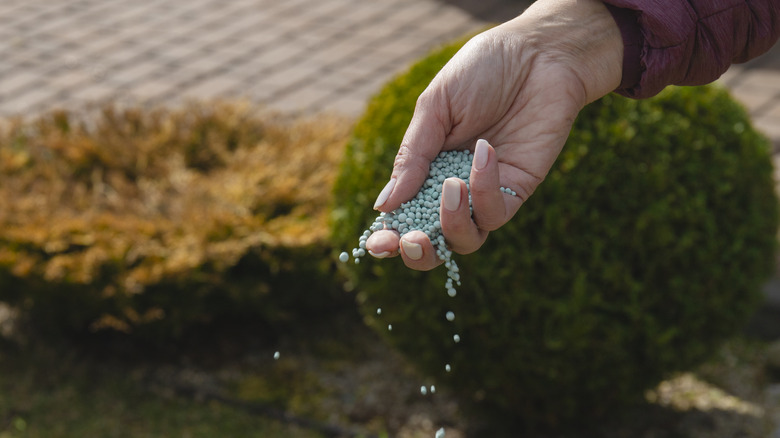The Fertilizer Ingredient That Can Encourage Pesky Crabgrass To Spread
Crabgrass is the bane of many homeowners' existence. With its coarse texture and chartreuse color, crabgrass sticks out like a sore thumb in otherwise uniform lawns and is infamously challenging to remove. While maintaining a healthy and thick lawn is one of the best ways to prevent crabgrass, if you've been fertilizing your lawn with a phosphorus-heavy fertilizer, especially during warm months, you've inadvertently encouraged this pesky weed to spread further.
As frustrating as crabgrass is, it's surprising to learn it was intentionally introduced to the United States in the mid-1800s with the idea that it could be a forage crop for livestock. Crabgrass has since spread throughout the U.S., forcing farmers and homeowners alike to be on guard. You will find two common kinds of crabgrass in the U.S.: large, also known as hairy crabgrass (Digitaria sanguinalis), and small or smooth crabgrass (Digitaria ischaemum). Both crabgrass types are summer annuals killed off by freezing temperatures but often reemerge from seeds the next spring.
Crabgrass prevention
Once crabgrass has become well-established in your yard, removing it can be an ongoing battle. In some cases, pre-emergent herbicides, including organic ones like corn gluten meal, can help you kill crabgrass before it can even sprout. Other popular and powerful solutions for putting an end to crabgrass include herbicidal sprays that can destroy existing crabgrass post-emergence.
As useful as these treatments can be, especially if crabgrass has already become a problem in your yard, maintaining a healthy lawn is the best defense against crabgrass. Crabgrass, like most weeds, is good at taking over patchy or thin areas of lawns, where it has little competition, so keeping your lawn thick and healthy can limit crabgrass's opportunities to thrive. Overseeding the patchy parts of your lawn in spring and fall gives the grass time to establish before the crabgrass seedlings emerge.
Be sure you know what kind of turf grass you use, as different grasses often have different needs. Fertilizing your lawn at the wrong time of year can end up feeding your crabgrass instead of your turf. For example, fertilizing cool-season grasses like fescues during the summer when they are primarily dormant does nothing to encourage the grass to grow. Instead, it simply feeds crabgrass, which thrives in the summer heat.
Phosphorus aids crabgrass growth
Don't just use any fertilizer on your lawn either; fertilizers high in phosphorus often help crabgrass and other weeds far more than they help your turf grass. Regarding numbers on a lawn fertilizer label, the first digit refers to nitrogen (N), the second to phosphorus (P), and the last to potassium (K). Phosphorus is important for plants as it encourages root growth, as well as other processes, but it is often already available in lawns in sufficient quantities. If you're concerned your lawn has a phosphorus deficiency, it's best to use a soil test to check your soil's health before adding a phosphorus-heavy fertilizer.
If your lawn has enough phosphorus, then a fertilizer labeled for lawn maintenance is likely the best option. Zero phosphorus fertilizers are also available if your lawn has excessive phosphorus levels. Not only does phosphorus encourage crabgrass to grow and set seed, but phosphorus runoff from lawns can damage nearby waterways and lead to algae blooms, which can harm aquatic life.


